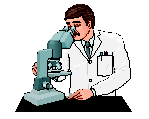| Module 6: Occupational Health Management - Section 3: Medical Screening and Surveillance |
| OHM3.5: Managment of Individual Screening Test Results |
Step One ("Case Identification"): Objective - "Normal or not"
 The objective here is to screen the target group for signs of work-related adverse health effects or for the presence of exclusion factors. This comprises clinical and laboratory screening tests conducted by appropriately trained personnel using approved equipment (eg. audiometry, lung function testing device, and laboratory equipment) and methods (eg. ATS, NIOSH, etc.). These tests need to be chosen carefully, and should have a high degree of validity. Usually the tests in phase one have a high degree of sensitivity, with a lower order of specificity. The tests results are captured, then printed and interpreted by an Occupational Medical Practitioner with training in this field.
The objective here is to screen the target group for signs of work-related adverse health effects or for the presence of exclusion factors. This comprises clinical and laboratory screening tests conducted by appropriately trained personnel using approved equipment (eg. audiometry, lung function testing device, and laboratory equipment) and methods (eg. ATS, NIOSH, etc.). These tests need to be chosen carefully, and should have a high degree of validity. Usually the tests in phase one have a high degree of sensitivity, with a lower order of specificity. The tests results are captured, then printed and interpreted by an Occupational Medical Practitioner with training in this field.
Cases of non-occupational adverse health findings (such as high blood pressure, poor vision, etc.) are excluded from further action, and are offered referral to a medical practitioner (facility) of their choice, for follow-up.
Those with adverse health effects thought to be work-related (whether exposure related or a potential exclusion) progress to Step Two.
Step Two ("Confirmation of work-relatedness of the Case"): Objective - "Work related or Not"
The objective here is to confirm work-relatedness for those with suspicious adverse health findings during Step One. This is a complex process that operates at the level of the individual screened and also at the level of the state of global knowledge derived from epidemiological surveillance and studies.
At the individual level, further confirmatory tests may be required to establish work-relatedness, and specialist expertise may be enlisted. These tests are usually more specific for the occupational disease being evaluated, in order to confirm the diagnosis (e.g. Tremor intensity), or to further determine work-relatedness (e.g. blood mercury levels) in a worker with a history of exposure.
Many jurisdictions, including South Africa which now has a schedule which is a modification (and improvement) of the current ILO schedule of occupational diseases. In South Africa, this schedule allows work-relatedness to be presumed if that disease appears in a column of the table against exposures known to cause such diseases in a corresponding column. Information is also available in the literature including MSDSs.
For more obscure relationships to work, the epidemiological literature should be consulted. Here the knowledge about work-relatedness is less established and is based on exposure-response or dose-response relationships observed in epidemiological studies. Such studies may be few or contradictory in findings. To assist the practitioner in coming to a decision about work-relatedness in relation to particular exposures, certain criteria may be employed e.g. the Bradford Hill Criterial for Causality as outlined in Appendix 3.
As with Step One, those with confirmed work-related abnormalities move on to Step Three, the rest are referred to their own health care providers.
Step Three ("Case Management"): Objective: - "Optimal Re-integration"
This is the final and most crucial component of the Screening and Surveillance programme. It focuses on those employees with confirmed work-related health problems. The actions in this phase include:

Case Reporting: Should an employee be found to be suffering from an occupational disease, it is required that the attending practitioner (nurse or doctor) notify the employee directly, the employer and the local offices of the Department of Labour (as prescribed by Section 25 in the Occupational Health and Safety Act. Statutory reporting requires the completion of a large number of documents, and a thorough understanding of the statutory mechanisms that govern these submissions. It is strongly advised that an Occupational Medicine Practitioner with the necessary experience is contracted for this component of the programme.
Case Submission: This comprises further data collection to satisfy the requirements of the Workmen’s Compensation Commissioner, and the submission of a claim. This includes the completion of the following documents as a minimum:
Frequently there are also a number of other (more specific) documents, too detailed to list here. These are all available from the Department of Labour.
It is important that the paperwork be correctly assembled or the worker can be seriously inconvenienced by unnecessary delays. The COID Commissioner is currently in the process of developing Instructions for a number of commonly occurring occupational diseases to assist the medical practitioner with accurate and complete submissions.